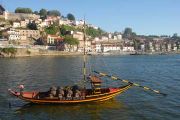Portugal’s second city, Porto is a patchwork of monuments of different styles tucked away in picturesque districts stretching over steep hills. Strolling around is very enjoyable and several wineries offer Port wine tasting.
[ Practical ]
Getting there
TAP Portugal operates daily flights to Porto from Paris, Nice, Lyon, Marseille and Toulouse. Transavia flies once or twice a day from Paris Orly to Porto.
Lodging
Eurostars das Arte
Grande Hotel de Paris
Guest House Douro
Ibis Porto Centro
Intercontinental Palacio das Cardosas
Mercure Porto Centro
Pensao Favorita
Pestana Porto
Restaurants
Abadia
A Grade
Chez Lapin
Cometa restaurante
ODE Porto Wine House
Pedro dos Frangos
Ze Bota
Getting around
Most of the monuments are easily accessible by foot.
Several metro lines crisscross the city and go as far as the sea and the airport.
Taxis are not expensive.
Good to know
A 3 days / 2 nights weekend allows to see the main sights.
Organized tours
Allow around 300 € per person for a package including the flights and 3 days / 2 nights stay in a double room with breakfast in a 3* hotel.
Travel companies
Estrela, D o n a t e l l o , F r a m, Lusitania, Voyageurs du Monde
Information
Portugal Tourist Office
135 Boulevard Haussmann, 75008 Paris.
Tel : 0811653838
www.visitportugal.com
Do as a growing number of tourists. Spend a weekend or few days in Porto. Charming, friendly and culturally lively, Portugal’s second city also boasts a large number of Romanesque, Gothic and Baroque monuments that owed its historical centre to be listed in UNESCO’s World Heritage list. Another asset is the still moderate price of hotels and restaurants.
 Outstanding view Outstanding view
The best place to start a tour of Porto is unquestionably the 172 m span Dom Luis I bridge, a double deck metallic structure engineered by a disciple of Gustave Eiffel. Now occupied by a metro line and a pedestrian walkway, the top deck indeed provides an unmatchable panoramic view of the city. Under your feet flows the Douro, a sometimes tumultuous river whose mouth is only 8 km away. On the right bank, Porto stretches over steep hills. On the left bank, the conurbation is not a district of the city but the small town of Villa Nova de Gaia that is more sheltered from the marine winds and thus better located for wine ageing. So, it’s there, that you will find the cellars of most of the famous Porto wineries such as Calem, Sandeman, Olly and Croft.

 Villa Nova de Gaia © T.Joly Villa Nova de Gaia © T.Joly
|
 Port wines Port wines
All offer guided tours of their premises and tasting of this wine that is neither aged nor produced in the town whose name it bears.
Grapes used to make it are indeed grown in the middle and upper Douro valley, 150 km inland, and it’s also there that the vinification usually takes place. A few boats with square sails once used to carry the barrels of young wine down the river are still visible along the quays of Villa Nova de Gaia. But, nowadays they only sail on the occasion of folk events or to take some tourists around.
The terrace of the Sandeman café is a good place to admire them as well as – in the background – the heart and cradle of Porto, the Ribeira district. Facing the port, it was for centuries only inhabited by fishermen and sailors.
 The cradle of Porto The cradle of Porto
Nowadays, its quays are lined with perfectly restored buildings with bright coloured facades, bars and popular restaurants serving traditional dishes.
But, behind this postcard image, you will find a maze of narrow streets, staircases and covered passageways lined with buildings with red tiled roofs whose granite walls are sometimes covered with brightly coloured corrugated iron sheets. This dark, humid, authentic and picturesque world is now undergoing radical transformation. Buildings are renovated, cleared from their metallic wrapping to make reappear the stones, dark shops and hash houses give place to trendy bars and stores attracting the youth.
Overlooking the Ribeira, next to remains of the medieval ramparts, the dark and forbidding silhouette of the fortress like Romanesque cathedral reminds of the troubled times when Porto was one of the outposts of the Reconquista.
 Baroque works Baroque works
A perfect example of this town where all kinds of architectural styles coexist side by side, it also comprises a gothic cloister.
Very wealthy from the 17th century thanks to trade with colonies and wine exports to England, Porto also boasts numerous baroque works and buildings whose gem is the Clerigos church. Its 75 m high tower bell – Portugal’s highest one – offers a great view over the city and used to be a landmark for sailors. Make sure you don’t miss the Santa Clara and Sao Francisco churches both gothic in style but whose interiors are entirely decorated with sculpted and gilded panelling. Besides, many churches facades are decorated with blue coloured azulejos.
 Lively market Lively market
A typical feature of Portugal, these painted, tin-glazed, ceramic tiles are also found on other buildings including the main hall of the Sao Bento railway station where they compose a fresco depicting the great moments of the country’s history. Nested in the heart of the old Porto, it is surrounded by commercial streets where shopping is like doing a cultural stroll because many stores have Art Nouveau, Belle Epoque or neo gothic facades. Let’s name the Majestic bar, the Lello & Imao bookshop, the Confeitaria do Bolhao confectionery,.. Right in front of the latest, stands the Bollhao, Porto’s largest market. Very picturesque and lively, it is full of all kinds of products and includes stalls offering mouth watering typical dishes.
As to the cultural renewal and the avant-garde side of Porto, they are symbolized by two monuments.

 Porto / Casa de Musica © T.Joly Porto / Casa de Musica © T.Joly
|
 Contemporary architecture Contemporary architecture
The casa de Musica, a concert room in shape of an irregular polyhedron built in 2005 by Dutch architect Rem Koolhas and the Contemporary Art Museum created by the greatest living Portuguese architect, Alvaro Siza Vieira. Located in Porto’s nicest park, the Serralves park, this building is nearby a remarkable Art Deco house dating from the 30s. During the late 19th century and early 20th century, many bourgeois preferred stay outside the city centre and moved to this district called Boavista where people who made their fortunes in the colonies ordered the construction of superb villas surrounded by gardens full tropical trees. And if you are fancy a break from the cultural visits, the Atlantic Ocean and its beaches are only a few kilometres away.
February 03, 2018
Thierry Joly 

|



